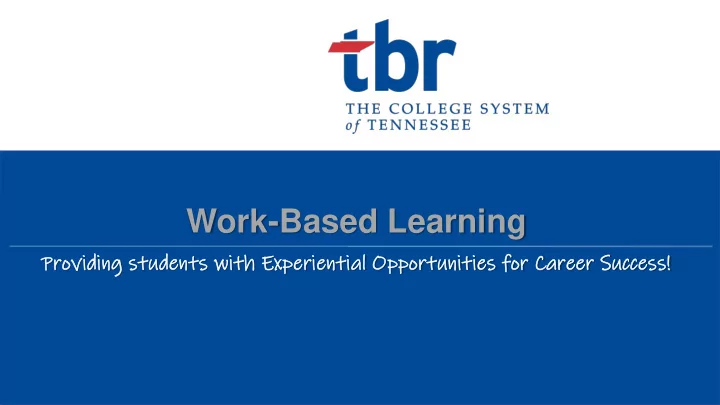

Work-Based Learning Pro rovid iding ing student nts s with Exp xperi rient ntial ial Opp pport rtunit ities ies for r Care reer Su r Succ ccess! ss!
3 Objectives • Deepen understanding of the value of WBL for postsecondary students, and how it supports their career goals • Create awareness of the benefits to industry, and the need to create strong partnerships • Promote consistency for WBL practices
4 What is Work-Based Learning • National practice that creates experiences for students to collaborate with industry to explore careers that interest them and gain valuable employability skills. (GA, CA, SC) • By working with employers, students apply classroom theories to practical problems, explore career options, and pursue personal and professional goals.
5 WBL= Multiple Quality Experiences Postsecondary Institutions • Industry speaker • Job Shadow • Internship Awareness Exploration Preparation & Training in the classroom need industry • Informational • Co-op/Paid support through • Career/Job Fair Interview work developing • Field Trips • Mentorships • Apprenticeship Strong Partnerships • Mock Interviews • SkillsUSA • Industry to be successful! competitions Certification • Career Interest Survey • Service-Learning and Volunteerism • School-based enterprises
6 WBL = Student Centered • WBL must be student centered : – Produces a portfolio of evidence of employability skills – Aligns to the student's selected program of study – Supports student's long-term goals and interests – Demonstrates growth of the student
7 WBL= Educator Supported WBL must be educator supported – Requires regularly facilitated reflection time to supplement work experience to meet course standards – Improves continuously through professional development, networking, and institutional support
8 WBL= Community Aligned • WBL must be community aligned: – Provides access to in-demand, high-skill, high-wage careers – Reflects state and regional workforce needs and trends – Encourages community ownership and collaboration
How does Work-Based Learning prepare our students for Career Success ?
10 Competitive Job Market Unemployment between 2% and 2.5% (blue) Unemployment between 4.2 and 5.1% (red) Statewide average is 3.5%
11 WBL= Competitive Applicants • Companies are struggling to find the talent they need because the labor market is competitive. • Work experience puts students on a strong path for postsecondary education completion and career attainment. • Employability skills provide students the ability to grow and adapt to an evolving workplace over their lifetime.
12 Strong WBL Programs • Guide students intentionally toward industry certifications, postsecondary education completion, and career attainment • Provide equitable access to students regardless of economic status or disability • Consider regional employment trends to connect students with opportunity
13 Equitable access matters “A lack of equitable access to work-based learning limits the career prospects and economic mobility of millions of youth and adults. It also prevents them from becoming part of the pipeline of skilled workers employers need to help spur local, state, and national economic growth.” Cahill, C. Making Work-Based Learning Work, Jobs for the Future, July 2016. http://www.jff.org/sites/default/files/publications/materials/WBL%20Principles%20Paper%20062416.pdf
14 WBL = Economic Mobility “ Uneven access to work-based learning threatens to curtail the economic mobility and career prospects of low-income and low- skilled individuals…” but “embedding work -based learning in programs of study helps promote equitable access for all students enrolled in the program, not just those with the personal relationships and social capital needed to access existing opportunities on their own.” Cahill, C. Making Work-Based Learning Work, Jobs for the Future, July 2016. http://www.jff.org/sites/default/files/publications/materials/WBL%20Principles%20Paper%20062416.pdf
How do we capture and assess the knowledge and skills gained by students in Work-Based Learning?
16 Portfolio = Artifacts Portfolio : Produces evidence of rigorous learning and skill development of the student. This evidence may be a final product, presentation, or performance that allows the student to fully demonstrate or articulate the depth of his/her achievement. • Collection of evidence of level of attainment • Method of summative performance assessment • Showcase of abilities represented in the student’s best work • A means of formative assessment • Documentation of stages of development
17 Assessing Portfolios 1. Multiple measures : In-class work and artifacts students produce are intended to provide a very clear and accurate picture of what the student has done and learned. 2. Use employer input : WBL instructor gains employer feedback throughout the student’s experience to determine level of mastery and performance. 3. Best artifacts: The portfolio should include the BEST examples of the student's performance and provide a thorough representation of knowledge and skills attained. 4. Intended for the student : The goal of the portfolio is to give students an additional tool to take with them when they graduate to assist in their career-level interviews.
18 Employability Skills Checklist
19 Employability Skills & Artifacts Example
20 Student Portfolio of Artifacts
21
22 Employability Skill Artifacts Brainstorm in Portfolio Artifact(s): APPLICATION OF ACADEMIC your groups. -Tangible pieces of evidence AND TECHNICAL KNOWLEDGE that prove the student has AND SKILLS mastered the employability s kill Write your CAREER KNOWLEDGE AND NAVIGATION SKILLS artifact ideas on 21ST CENTURY LEARNING sticky notes and AND INNOVATION SKILLS place on PERSONAL AND SOCIAL coordinating SKILLS poster.
Gallery Walk
31
32 Next Steps • Follow up email to participants- Presentation, digital copy of handout, campus artifact examples, campus point-of-contact (cc) • Spring 2019: Regional Collaborative Work Groups with Industry Partners (Drive-In) • Recommend campus-level WBL Point of Contact WBL coordinator and/or instructor(s) who utilize work-based learning in their programs, and industry WBL partner
33 Questions? Joy.Rich@tbr.edu
Recommend
More recommend